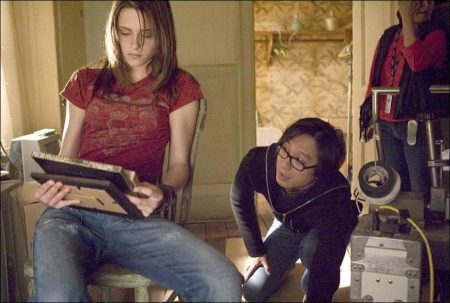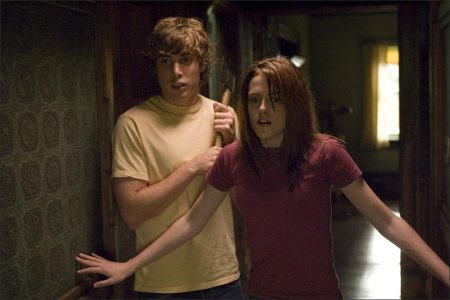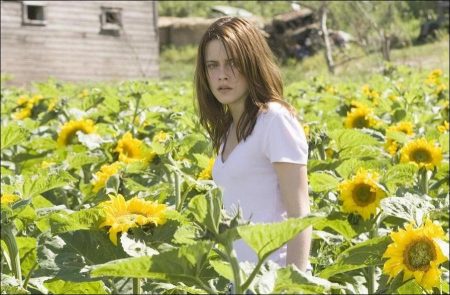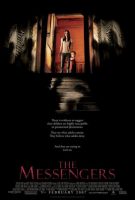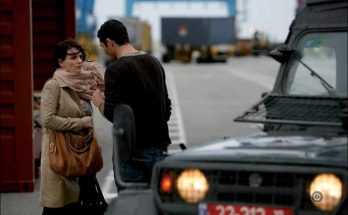The Messengers Movie Trailer. Psychotherapy and mythic story telling share a common metaphor – utilizing the haunted house to replicate the haunted mind. Some rooms are too painful to enter, some inner demons buried deep in the basement of the subconscious, too terrifying to explore. And often the irritating unresolved that continuously rattles around in the hallways of the unconscious is what the mind tries to rationalize away. It is why, says Producer Rob Tapert, horror films played out in haunted houses are so effective, the anticipation of the scare, the heightened sense of dread. It is why the buildup never ceases to render audiences spellbound and why the haunted house strikes a common nerve.
It is what Jess experiences on both levels, her mental torment reflected in her outer world. “This is a ghost story about a family who moves into this house that’s haunted and the girl is pretty much the only one who’s being affected by these supernatural beings and no one else believes her,” says Actress Kristen Stewart, who plays Jess. “It is crazy because these things are attacking my character and no one else has ever seen them.”
No one except her 3-year-old brother Ben, who she realizes has always seen them but he doesn’t speak. Jess’ awareness is more gradual. “My character is trying to figure it out and thinks maybe she is crazy, maybe none of this is really happening and she’s been going through a lot and this is how it is manifesting itself,” explains Stewart. “But it turns out it is not a figment of her imagination at all. When something happens in the middle of the night, that’s too weird to explain, she doesn’t have the family support system to wake them up and say `look something’s going on.’ And the thing is her family would love to be there for her but they’re in a weird stage of their relationship and the trust is gone.
“She’s already completely isolated living on this farm in the middle of nowhere and she doesn’t want to be there, but she figures there’s nothing she can do about it. And her parents know that she doesn’t want to be there, so she can’t really tell her parents what she’s experiencing because they think she’s nuts and they don’t believe her. So she gets to a point where she needs to figure out why this is happening because if no one else is going to help her, she has to do it herself.”
For Jess’ mother Denise, Miller says the loss of trust in her daughter builds tension in what is essentially a happy relationship with her husband Roy. “I (Denise) can’t count on my daughter, can’t rely on her. (In Chicago), Jess got into some real trouble and my character is having a hard time forgiving her. She sees her daughter as being overly dramatic and wanting to go back to Chicago and I think, on some level, maybe feels she’s failed her as a parent. There’s a real dance going on between us and in suspense, a horror film, there’s a lot of character driven dramatic content that you don’t usually see.”
Pulling from his own experience, McDermott remembers “I was a mess when I was a kid. It is complicated when kids become teenagers, a lot of angst and a lot of emotion. There is a scene where Jess ends up with cuts on her neck and it becomes very worrisome for my character. Is she delusional? What’s going to happen to my daughter? Maybe what happened in Chicago wasn’t one isolated incident. Where is she emotionally?
This house is so ominous and behind the door its dark and you’re on this farm and nobody’s around. So it is this sense of isolation and being sort of lost in it.” And, Roy is haunted by his own decision to uproot his family and chase his dream of working the farm and returning to his roots after realizing he didn’t fit in the big city.
Pushing Up Sunflowers
“Always sunny, very calm, the sunflowers just kind of sway in this serenity, oblivious to the menace of the crows or the chaos of the past that is literally surfacing out of the ground they are growing in…it’s just creepy…an awesome contradiction between the setting and the action of this movie.” – Kristen Stewart.
That contradiction numbered 65,000 stems in full bloom across a four-acre field on the fictional Solomon farm set near Regina, Saskatchewan, Canada. “The sunflowers were really the first tremendous project off the top that we to think about because they were such an enormous element in this movie,” says Production Designer Alicia Keywan. “So big that we had to have at least three plans of attack that we could shoot them on the day we wanted and have the look we were trying to achieve.
We had to find the field, plant the field and that required a lot of research, checking into the soil, finding out if it would work at all, researching the different types of sunflowers, what height they would grow to at what times of year, dealing with some of the local farmers and it was all on speculation. And of course if it all fell through, we would be ordering 5,000 silk sunflowers from China at the last minute, planting silks all over the place which is kind of a typical movie thing to do!” she says, laughing. “That would have been our last resort. They never compare to the real thing and you can tell.”
Keywan continues, “Lo and behold they came into bloom the exact day we were filming here in Regina. Just a few days before only a few were in bloom. But the day we arrived to shoot, 60 percent had these gorgeous yellow heads looking up to the sun. They follow the sun. It was really a glorious moment to see them all come out.”
The sunflowers were more than just a colorful, extravagant prop. They are the Solomons second chance. Roy not only walked away from a career in Chicago, he banked everything on the farm and its sunflower crop. But his dreams are dashed when the crop is failing to produce, he can’t pay his monthly note on the farm, his daughter is terrified and his wife no longer wants to live in the house and the bank manager keeps showing up to pressure him to sell. “He is the bane of Roy’s existence,” says McDermott. “If only I (Roy) could get to harvest and sell the sunflowers and make some money, hand him the money, it would be alright. But he doesn’t understand. He just doesn’t get it and I’m screwed.”
Bank Manager Price has little confidence that the Solomons will make it happen, says William B. Davis, better known as the infamous Cancer man on the hit television series The X-Files. There’s a buyer with a better offer “and he keeps trying to encourage Roy to take it,” says Davis, who plays Price. “He knows something terrible happened there, that the house is haunted, that it just sat there for years.”
With that knowledge in mind, “there’s something spooky about growing sunflowers that gives you this sense of being happy and safe and secure…like echoes of The Wizard of Oz. But it’s not the sunflowers that act up, it’s the crows they attract. But they behave unlike crows normally behave. They are almost human in some way, menacing spirits. It’s the way they protect the house against intruders, almost like vultures waiting for anything to suffer or die so they can feed.”
Don’t Shoot the Messenger…
…Quoth the Raven, “Nevermore.”
“And the Raven, never flitting, still is sitting, still is sitting…. just above my chamber door;
And his eyes have all the seeming of a demon’s that is dreaming,
And the lamplight o’er him streaming throws his shadow on the floor;
And my soul from out that shadow that lies floating on the floor
Shall be lifted- nevermore!”
— Edgar Allen Poe, THE RAVEN
“The crows are like a signal, a kind of warning but they cannot speak. So they must try to communicate through their actions,” says Oxide Pang. “They are a messenger to the living.”
Messengers, adds his brother Danny, that “are difficult to control.” THE MESSENGERS’ crows are really ravens imported from the Czech Republic, owned and trained by Ota Bares, a raven trainer from Prague.
“They are a very eerie bird,” notes Producer Sherak. “You always wonder whether or not they are protecting the Solomons, warning them, or something more sinister. They are a very smart bird and that definitely comes across.” Notes Bares, whose birds have appeared in BLACK DAHLIA and COLD MOUNTAIN, “sometimes it can be difficult to make them do what you want because they are just thinking too much.”
Visual Effects Supervisor Bruce Jones, whose job was to duplicate Bares’ flock of 25 ravens by the thousands through imaging, calls the bird actors portraying crows “psycho pumps. They are characters that live between the land of the living and the land of the dead. When we see a `crow’ show up, we think it is an evil character. But in a sense they are actually warning us there’s another evil coming. We don’t know that and so we think they are bad.”
For Production Designer Alicia Keywan, “I find the birds very scary. Who didn’t see Hitchcock’s (1963 horror classic) THE BIRDS? Birds will always have that connotation for me. They’re quite spectacular.”
For Stewart’s character Jess they are a constant in her world on the farm. “They become this permanent fixture,” she says. “At first I (Jess) see them as part of life on a sunflower farm, always flying around until I realize they always seem to be there when situations turn creepy. When my character first comes into the house, she’s checking it out and a black thing kind of flashes by the window. They’re very mysterious, very ominous and are always messing with my (character’s) head.”
It was the “messing with the head’ part that terrified Corbett, literally. “I was really nervous having them around my face because there are a couple of scenes where they attack and you can lose an eye quickly with a little peck,” Corbett says. “I’m not a fan of birds anyway because I had a parrot that almost took my finger off a couple of times. So they gave me a bird double, Petr Staka, and he is used to having them crawl all over him.” Staka is one of Bares’ assistants from the Czech Republic. Corbett believes it is because the crows are actually ravens that the scenes with the birds come off as so terrifying. “They have these big beaks that are long and thick and strong necks and talons…a predator like an eagle or a hawk.”
Although intimidating, Bares says they are loyal and friendly birds, “remembering things for a long time and can even recognize a (former) owner after 10 years.” Producer Shuman lauded Bares’ handling of the ravens, adding “they are so well trained with probably better credits than I have!”
The Scaring Point
“It’s rugged. It’s dirty. It is dark and sharp-looking. There are no soft edges. It is like everything on the farm – hard, like the scythes and the sickles and the old dead tractor.” This is how Stewart sees Jess’ new home and new world.
The farmhouse is old and battered and dark brown, juxtaposed against all those beautiful sunflowers, says Miller. And on the inside, it tells a far different story from the outer world.
The interior sets were all about “circles of movement so that everything opens into some outer space,” says Production Designer Keywan. “There are no dead ends. It helps construct tension, the sense that there could always be someone immediately outside of a doorway, in any other room… the illusion of the unknown always lurking.”
After the Solomon family moves into what they had hoped would be their dream house, “they start to feel everything strange and more and more things emerge out of the dark corners into the light,” says Danny Pang. “It is all about reaching the scaring point.”
That point is enhanced by color as well as light, notes Director of Photography Geddes. “In Chinese mythology, the power of the ghost is relevant to color and the strongest is green.” The whole house, adds Keywan, was designed in shades of green with wood accents. “The darker the lighting and shade of green, the better,” says Geddes.
“There are a lot of spooky things inside the house and the lighting is all done through the windows. It has a very realistic feel of being in an old, smallwindowed farmhouse with little shafts of light coming in,” Keywan says. “The dark elements make for a moody ambience which adds to the aura of mystery.”
There was more to light than just a tweak on the genre. Since the film was shot in Canada at a time of the year when there were only about four hours of darkness with daylight stretching until 10:30 and 11 p.m., the filmmakers had to deal with guild rules that allowed child actors to only work until midnight. “It worked to our advantage that daytime was scary as well,” Geddes says.
The film was shot about 100 miles north of the Montana / North Dakota border in Canada’s central plains region, just outside of Regina, the provincial capital of Saskatchewan. A farming region, Regina’s central crops are wheat, canola, flax and sunflowers. “We needed a place where we could have a sunflower farm at the exact time we were shooting the movie,” says Producer Shuman. “Saskatchewan happened to be a place that had vast lands, could afford our sunflower timing and is movie-friendly.” It is home to Canada’s Saskatchewan Production Studios, which house state of the art soundstages, editing facilities and currently produces the popular television series CORNER GAS, a parody on Canadian prairie life.
When Keywan took the Pangs to scout the farmhouse location on the land just outside Indian Head in the Qu’Appelle Valley, “it was winter and they had just arrived from Hong Kong via Los Angeles. Someone wrapped them up in borrowed down coats and told them to get on the snowmobiles and hang on,” she recalls. “At that time of year, none of the roads coming in were roads you could actually drive on, so it was five miles in the snow. When we arrived they didn’t say much, just got off and walked around. After a few minutes, Oxide said `there’s nothing like this is Southeast Asia. I’ve only seen this in movies.’ I said `well, now it’s in yours’.”
Shuman, who was along on the scouting expedition, remembers coming upon the exact hillside. “We looked out at this huge, vast expanse and the Pangs knew exactly where they wanted the house. It was fascinating,” he says, “because there was absolutely nothing there except open land and snow. It was snowing. They knew they wanted a certain distance from the house to the hill and they knew exactly where they wanted the barn hidden behind the hill. The script just said `a house on a farm’ but the Pangs had put so much detail of thought into it, they had a vision of exactly how they were going to extract the tension, the terror of that house at that moment. They knew, in their own way, what it meant to have the house set against those looming trees in the background. It was something to watch.”
For Sherak, Shuman’s producing partner at Blue Star Pictures’, “You know I really think it is the setting that tends to make a movie really horrific. Being in Regina on a farm is such an isolated area to shoot, there is this odd feeling of claustrophobia in nothing but open space. That mixed with ghosts is just a very horrific feeling. And then you have this family’s story where the kids see the ghosts before the parents and convincing them to get out and it is not going well. By the time they do figure it out and start to believe, it’s a little too late.”
The Messengers (2007)
Directed by: Oxide Pang, Danny Pang
Starring: Kristen Stewart, Dylan McDermott, Penelope Ann Miller, John Corbett, Evan Turner, Theodore Turner, Jodelle Ferland, Tatiana Maslany, Shirley McQueen, Anna Hagan
Screenplay by: Mark Wheaton, Stuart Beattie, Todd Farmer
Production Design by: Alicia Keywan
Cinematography by: David Geddes
Film Editing by: John Axelrad, Armen Minasian
Costume Design by: Mary Hyde-Kerr, Cathy McComb
Set Decoration by: Henry Thomas Earle, Sara McCudden
Art Direction by: Ken Watkins
Music by: Joseph LoDuca
MPAA Rating: PG-13 for mature thematic material, disturbing violence and terror.
Distributed by: Columbia Pictures
Release Date: February 2, 2007
Views: 161
